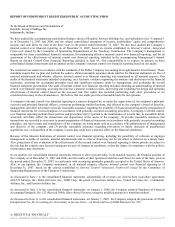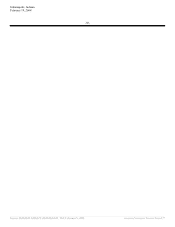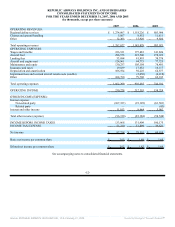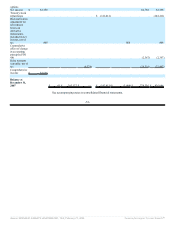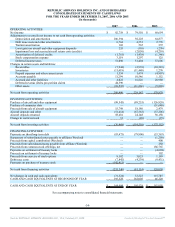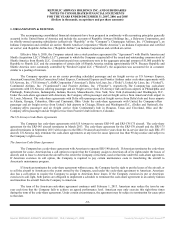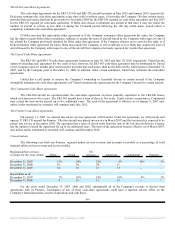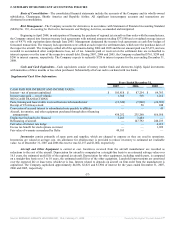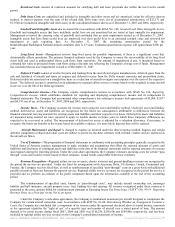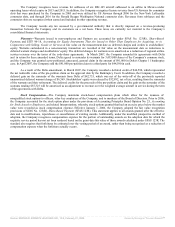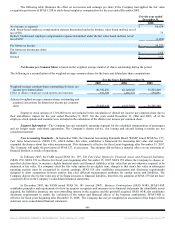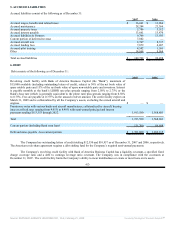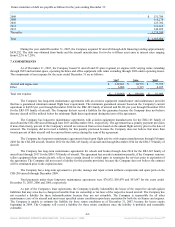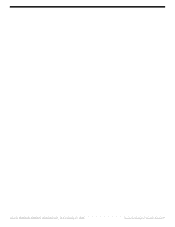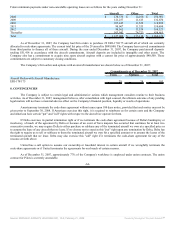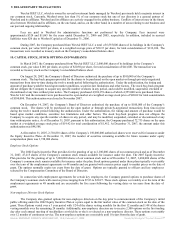Frontier Airlines 2007 Annual Report Download - page 71
Download and view the complete annual report
Please find page 71 of the 2007 Frontier Airlines annual report below. You can navigate through the pages in the report by either clicking on the pages listed below, or by using the keyword search tool below to find specific information within the annual report.
Restricted Cash consists of restricted amounts for satisfying debt and lease payments due within the next twelve month
period.
Debt Issue Costs are capitalized and included in intangible and other assets and are amortized, using the effective interest
method, to interest expense over the term of the related debt. Debt issue costs, net of accumulated amortization, of $22,271 and
$17,560 are included in intangible and other assets in the consolidated balance sheets as of December 31, 2007 and 2006, respectively.
Goodwill and Intangible Assets are accounted for in accordance with SFAS No. 142, Goodwill and Other Intangible Assets.
Goodwill and intangible assets that have indefinite useful lives are not amortized but are tested at least annually for impairment.
Management reviewed the carrying value of goodwill and concluded that no asset impairment existed as of December 31, 2007.
Intangible assets that have finite useful lives are amortized over their useful lives to an estimated residual value and reviewed for
impairment at each reporting date. At December 31, 2007 the remaining amortization period for the
Ronald Reagan Washington National Airport commuter slots is 23 years. Estimated amortization expense will approximate $388 per
year.
Long-Lived Assets—Management reviews long-lived assets for possible impairment, if there is a significant event that
detrimentally affects operations. The primary financial indicator used by the Company to assess the recoverability of its long-lived
assets held and used is undiscounted future cash flows from operations. The amount of impairment if any, is measured based on
estimated fair value or projected future cash flows using a discount rate reflecting the Company's average cost of funds. Management
has concluded that no asset impairment existed as of December 31, 2007.
Deferred Credits consist of credits for parts and training from the aircraft and engine manufacturers, deferred gains from the
sale and leaseback of aircraft and spare jet engines and deferred revenue from the Delta warrant surrender and pre-petition claim.
Deferred credits are amortized on a straight-line basis as a reduction of aircraft or engine rent expense over the term of the respective
leases. The deferred revenue is amortized as an adjustment to regional airline services revenue based on the weighted average aircraft
in service over the life of the Delta agreements.
Comprehensive Income—The Company reports comprehensive income in accordance with SFAS No. 130, Reporting
Comprehensive Income, which establishes standards for reporting and displaying comprehensive income and its components in
financial statements. The Company had accumulated other comprehensive loss relating to treasury lock agreements of $3,009, $3,877
and $4,176, net of tax, at December 31, 2007, 2006 and 2005, respectively.
Income Taxes—The Company accounts for income taxes using the asset and liability method. Under the asset and liability
method, deferred tax assets and liabilities are recognized for the future tax consequences attributable to differences between the
financial statement carrying amounts for existing assets and liabilities and their respective tax bases. Deferred tax assets and liabilities
are measured using enacted tax rates expected to apply to taxable income in future years in which those temporary differences are
expected to be recovered or settled. The measurement of deferred tax assets is adjusted by a valuation allowance, if necessary, to
recognize the future tax benefits to the extent, based on available evidence; it is more likely than not they will be realized.
Aircraft Maintenance and Repair is charged to expense as incurred under the direct expense method. Engines and certain
airframe component overhaul and repair costs are subject to power-by-the-hour contracts with external vendors and are expensed as
the aircraft are flown.
Use of Estimates—The preparation of financial statements in conformity with accounting principles generally accepted in the
United States of America requires management to make estimates and assumptions that affect the reported amounts of assets and
liabilities and disclosure of contingent assets and liabilities at the date of the financial statements and the reported amounts of revenues
and expenses during the reporting periods. Under the code-share agreements, the Company estimates operating costs for certain “pass
through” costs and records revenue based on these estimates. Actual results could differ from those estimates.
Revenue Recognition—Regional airline service revenues, charter revenues and ground handling revenues are recognized in
the period the services are provided. Under our fixed-fee arrangements with American, Delta, US Airways, United, Continental and
Frontier, the Company receives fixed-fees, as well as reimbursement of specified “pass-through” costs on a gross basis with additional
possible incentives from our Partners for superior service. Regional airline service revenues are recognized in the period the service is
provided and we perform an estimate of the profit component based upon the information available at the end of the accounting
period.
The reimbursement of specified costs, known as “pass-through costs”, may include aircraft ownership cost, passenger
liability and hull insurance, aircraft property taxes, fuel, landing fees and catering. All revenue recognized under these contracts is
presented at the gross amount billed for reimbursement pursuant to Emerging Issues Tax Force Issue (“EITF”) No. 99-19 Reporting
Revenue Gross as a Principal versus Net as an Agent.
Under the Company’s code-share agreements, the Company is reimbursed an amount per aircraft designed to compensate the
Company for certain aircraft ownership costs. In accordance with EITF No. 01-08, Determining Whether an Arrangement Contains a
Lease, the Company has concluded that a component of its revenue under the agreement discussed above is rental income, inasmuch
as the agreement identifies the “right of use” of a specific type and number of aircraft over a stated period of time. The amount
deemed to be rental income during fiscal 2007, 2006 and 2005 was $310,250, $258,600 and $189,800, respectively, and has been
included in regional airline services revenue on the Company’s consolidated statements of income.
Source: REPUBLIC AIRWAYS HOLDINGS INC, 10-K, February 21, 2008 Powered by Morningstar® Document Research℠


